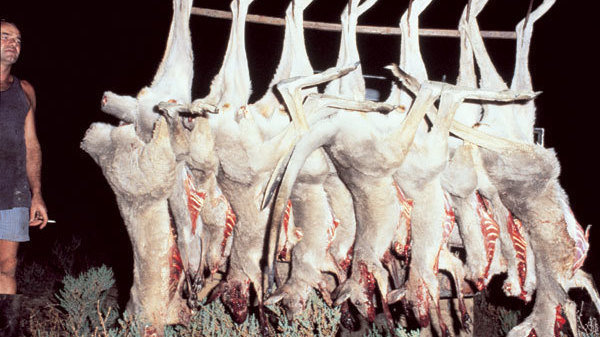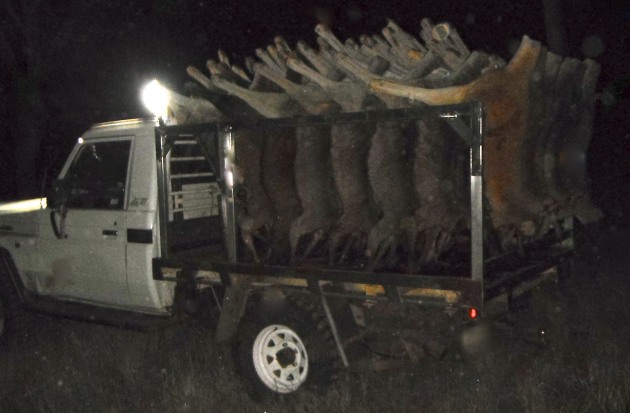A search of the internet brings forth the often quoted number of 50 million kangaroos in Australia, two kangaroos per person. This figure came from the Federal Government in 2016. The page is http://www.environment.gov.au/system/files/pages/d3f58a89-4fdf-43ca-8763-bbfd6048c303/files/kangaroo-statistics-new.pdf
If you clicked on the above link, you discovered that the page was no longer available. The content has been removed, which means that the source of the 50 million figure has disappeared – but the frequency with which this figure is quoted has not.
Even if there are 50 million kangaroos, which there isn’t, Australia is 7.692 million square kilometres. That means there are only 6.5 kangaroos per square kilometre. The quasi-extinction density is five kangaroos per square kilometre and extinction threat density is two kangaroos per square kilometre. While 50 million sounds like a lot of kangaroos, this figure equates to 6.5 kangaroos per square kilometre, just 1.5 above the quasi-extinction density.
Australia should have a lot more than 50 million kangaroos.
According to our research, various sources say that kangaroo numbers peaked in 2016. Since then, kangaroo numbers have crashed for a number of reasons: legal and illegal hunting, disease, bushfires and drought.
Let’s look at examples from each state.
South Australia
In 2018, there were 2,250,094 red kangaroos, 1,241,347 eastern grey kangaroos and 615,675 euro wallabies in the commercial hunting zones of South Australia.
In 2019, there were an estimated 1,552,679 red kangaroos. This is a massive decline, even more so because the commercial hunting zones of South Australia increased to cover all of the state. We’re not comparing apples with apples due to 2018 estimates being for a limited area and 2019 estimates being for the whole state. Therefore the decline in red kangaroos is even more dramatic.
In 2019, western grey kangaroos were not counted in the Eyre Peninsula, which covers two regions of the state, so estimates are unavailable.
The most significant decline, with numbers crashing, goes to the euro wallaby. In 2019, estimates crashed to 61,826 – 10% of the 2018 estimate. Yet, commercial hunting continues at a quota of 7,400 a year or 12%.
The Tammar Wallaby was extinct in South Australia. Tammar Wallabies were once common on the Eyre, Yorke and Fleurieu Peninsulas but were driven to extinction by land clearing and introduced predators. They were reintroduced into South Australia in 2004.
Spotlight driving surveys were used on Kangaroo Island to survey the Tammar Wallaby population as this species is generally most active at night. The result is an estimate of 87,043 and a commercial hunting quota of 8,700 or 10%
Queensland
The Kangaroo Management Plans for Queensland calculate estimates in terms of kangaroo density per square kilometre.
In 2016, Cunnamulla had a red kangaroo density of 16.54. That means there were on average 16.54 kangaroos per square kilometre. In 2019, the density crashed to 5.56. The quasi-extinction density is five kangaroos per square kiolmetre.
In 2015, Hungerford had a red kangaroo density of 9.7. In 2019, the density crashed to 0.65.
In 2016, Cunnamulla had an eastern grey kangaroo density of 18.73. In 2019, the density plummeted to 5.10.
In 2016, Injune had an eastern grey kangaroo density of 40.62. In 2019, the density fell to 25.97.
New South Wales
The below figures are prior to the 2019/20 bushfires that destroyed more than five million hectares across New South Wales.
In 2016, Tibooburra had a red kangaroo population of 1,567,598. In 2019, the estimated number of red kangaroos crashed to 79,346. That’s a loss of 1,488,252 kangaroos or 95%.
In 2016, Cobar had a red kangaroo population of 437,129. In 2019, the estimated number of red kangaroos plummeted to 36,058. That’s a loss of 401,071 kangaroos or 92%.
In 2016, Tibooburra had a grey kangaroo population of 451,594. In 2019, the estimated number of grey kangaroos dropped to 48,502. That’s a loss of 403,092 kangaroos or 89%.
In 2016, Broken Hill had a grey kangaroo population of 672,187. In 2019, the estimated number of grey kangaroos fell to 326,644. That’s a loss of 345,543 kangaroos or 51%.
Bear in mind that surveyors can’t distinguish between the eastern grey kangaroo and the western grey kangaroo during aerial surveys, so they simply lump the two species together. This strategy means that either species could be endangered or extinct in New South Wales and no one would ever know.
Western Australia
Western Australia is a little different. Kangaroo numbers appeared to peak in 2018, then crash at alarming rates.
In 2018, there were an estimated 1,825,760 red kangaroos. The following year, estimated numbers plunged to 1,278,620 – a decline of 30%.
In 2018, there were an estimated 2,423,800 eastern grey kangaroos. The following year, estimates fell to 1,811,985 – a decline of 25%.
Victoria
There are no estimates available prior to 2018 and no estimates since then.
What can be deduced from the 2018 density figures and quotas is that the Victorian Government is encouraging the hunting of kangaroos at risk of extinction – that is, with populations of two kangaroos per square kilometre.
** Given the above crashes in kangaroo populations across Australia, it’s impossible for there to be 50 million kangaroos in 2020. The number is more likely to be 25 million, or possibly even much lower.

